The Town of Belley in the Early History of the Society of Mary
Part 2 of 2
The Cathedral and Bishop Devie
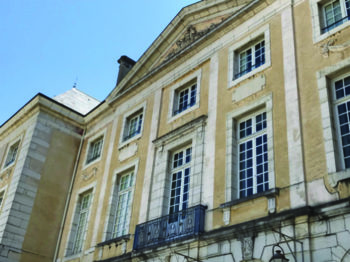
Bishop's palace, Belley
Work began on the Cathedral in the 12th century, the builders added a lofty Gothic chancel in the 1400s, and in 1835 the transformation into its present form began. In 1851 it was complete. For such a small town, it was an enormous building. Bishop Devie’s tomb is in the floor of a chapel on the left. Fr Colin had great admiration for Bishop Devie: “Monsignor Devie is one of the finest examples of a bishop that I know. When he was appointed, the region, Ain, was abandoned. He has renewed it entirely”. And Bishop Devie had great respect for Fr Colin, which did not mean that their relationship was always comfortable. Arguments came about because Devie wanted the Society of Mary to remain a congregation within his diocese -- he did not want to lose good men to other dioceses. Colin’s vision for the Society was international, with people “going from place to place”.
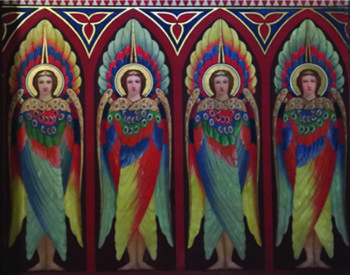
Altar panel, Belley Cathedral
The relationship between Devie and Colin did not lack lively and loud conversations. Over several years, Fr Colin implored Bishop Devie to relieve him of his duty as Superior of the College, without success. Fr Colin tried to avoid his appointment as a Canon of the Cathedral. Bishop Devie appointed him nonetheless. Presented with the Canon’s cape, Colin left it with the porter of the bishop’s house. From a window upstairs, the bishop saw Colin slinking away without the cape. He yelled at him to come back and get it!
Marist Laity in Belley
The first retreat given to Marist laity took place in the chapel at Bon Repos, at the beginning of Lent in 1833. Jeanne-Marie Chavoin took part in the retreat, at which ten women from the town were present, and wrote of it in a letter. The group was called the ‘Confraternity of the Mother of God for the conversion of sinners and the perseverance of the just'. Its aim, in Fr Colin's words, was “to excite faith among Catholics, to unite the Christian faithful by links of love and zeal for Mary, so that they are members of a family having the Mother of God for its Mother; and to cooperate as much as possible with the religious of the Society of Mary for the conversion of sinners and the perseverance of the just”.
At the same time, a Third Order branch in Lyons, with Jean Baptiste Pompallier as its chaplain, was known as ‘The Tertiary Brothers of the Society of Mary’ (Hosie, p. 120).
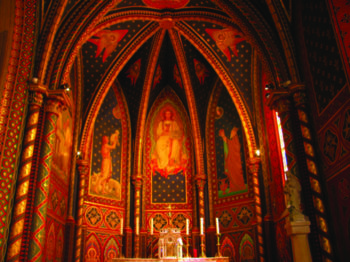
Cathedral, Blessed Sacrament Chapel
La Capucinière
La Capucinière was the first house owned by the Marists, given to them by Bishop Devie in 1832, in exchange for a house left to Fr Colin by Fr Pichat, which the bishop wanted for one of his canons. When the bishop was slow in transferring the ownership of the house, Fr Colin took him to task: “I experienced against the bishop ... an incredible burst of rage. ... I rushed to the palace. ... I banged on the door ... and threw myself at the feet of the bishop, showing my feelings of annoyance and rebellion”. (Hosie, pp 119-20).
Fr Colin considered La Capucinière to be “the cradle of the Society”. This was the house in which Fr Colin was chosen to be superior general, and where the first Marist professions took place on 24 September 1836.
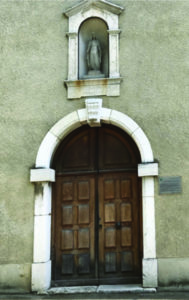
Entrance, La Capucinière
Twenty men made their first vows. Four of them – Jean Claude Colin, Marcellin Champagnat, Etienne Déclas and Etienne Teraillon – had signed the Fourvière pledge (see MM, October 2018, pp 33 ff). Of the twenty who made their vows, nine were from the diocese of Lyons and eleven from the diocese of Belley. Fr Colin remained there until 1839, when he moved to Puylata in Lyons (see MM, November 2018, p 39).
From 1834, La Capucinière was a scholasticate as well as a boarding school. It served as a novitiate until 1860 for non-ordained Marist candidates, after which the novitiate was at Ste Foy in Lyons (see ibid, p 40). It was the scholasticate from 1860 until 1880, when the scholasticate moved to Ste Foy.
La Capucinière was sold to the town of Belley in 1958. From the time of the Marists, the outside walls and the chapel where the Marists took their vows remain, and the altar steps on which they knelt are as they were then.
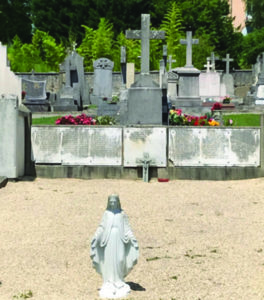 SM Graves in Belley |
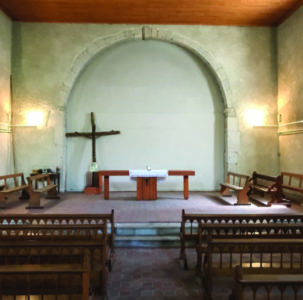 La Capucinière, sanctuary |
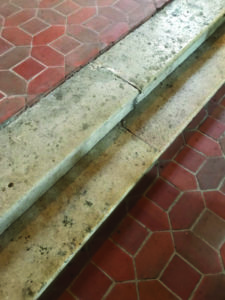 La Capucinière, steps |
|
 Entries(RSS)
Entries(RSS)